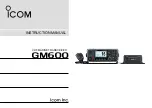
Installation 15
Selecting Current Transformers
The rated full-scale current of the CTs should normally be chosen somewhat above the maximum
current of the circuit being measured (see
below for more details). In some
cases, you might select CTs with a lower rated current to optimize accuracy at lower current
readings. Take care that the maximum allowable current for the CT can not be exceeded without
tripping a circuit breaker or fuse; see
We only offer CTs that measure AC current, not DC current. Significant DC current can saturate
the CT magnetic core, reducing the AC accuracy. Most loads only have AC current, but some
rare loads draw DC current, which can cause measurement errors. See the website article
DC Current and Half-Wave Rectified Loads
for more information.
CTs can measure lower currents than they were designed for by passing the conductor through
the CT more than once. For example, to measure currents up to 1 amp with a 5 amp CT, loop the
conductor through the CT five times. The CT is now effectively a 1 amp CT instead of a 5 amp
CT. The effective current rating of the CT is the labeled rating divided by the number of times that
the conductor passes through the CT.
If you are using the measurement phases of the WattNode (
Ø
A
,
Ø
B
, and
Ø
C
) to measure different
circuits (as with
Option P3
), you can use CTs with different rated current on the different phases.
Current Crest Factor
The term “current crest factor” is used to describe the ratio of the peak current to the RMS cur-
rent (the RMS current is the value reported by multimeters and the WattNode meter). Resistive
loads like heaters and incandescent lights have nearly sinusoidal current waveforms with a crest
factor near 1.4. Power factor corrected loads such as electronic lighting ballasts and computer
power supplies typically have a crest factor of 1.4 to 1.5. Battery chargers, VFD motor controls,
and other nonlinear loads can have current crest factors ranging from 2.0 to 3.0, and even higher.
High current crest factors are usually not an issue when metering whole building loads, but can
be a concern when metering individual loads with high current crest factors. If the peak current is
too high, the meter’s CT inputs can clip, causing inaccurate readings.
This means that when measuring loads with high current crest factors, you may want to be
conservative in selecting the CT rated current. For example, if your load draws 10 amps RMS, but
has a crest factor of 3.0, then the peak current is 30 amps. If you use a 15 amp CT, the meter will
not be able to accurately measure the 30 amp peak current. Note: this is a limitation of the meter
measurement circuitry, not the CT.
The following graph shows the maximum RMS current for accurate measurements as a function
of the current waveform crest factor. The current is shown as a percentage of CT rated current.
For example, if you have a 10 amp load with a crest factor of 2.0, the maximum CT current is
approximately 85%. Eighty-five percent of 15 amps is 12.75, which is higher than 10 amps, so
your measurements should be accurate. On the other hand, if you have a 40 amp load with a
crest factor of 4.0, the maximum CT current is 42%. Forty-two percent of a 100 amp CT is 42
amps, so you would need a 100 amp CT to accurately measure this 40 amp load.
















































